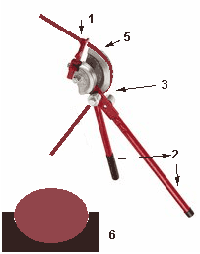Bending copper pipe can be done properly in two ways, ether a tool called a bending spring is used or a more substantial tool called a proprietary plumbers copper pipe bender is used.
It can be a little tricky bending pipes if you have never done it before so in this guide we will show you how to bend copper pipe using a bending spring or plumbers pipe bender.
Why Bend Copper Pipe?
If you attempt to bend copper pipe without either of these tools it will kink. Kinks in pipes of any kind reduce the diameter of a pipe and if the diameter is reduced, the flow is reduced and the whole system becomes less effective as well as being more prone to blockage and irregular pressures.
This is one of the reasons plumbers prefer to use a copper pipe bender rather than simply cut the pipe and put a bend fitting like an elbow into the run to change direction.
Pipe fittings change direction very quickly to allow tight corners to be formed but the very tightness of these corners can reduce the effectiveness of the pipe run.
As the water flows down the "straight" all of a sudden it encounters a tight, right angled bend. Because the bend is so tight the water simply hits the side of the fitting before going round the corner.
This turbulence in the water can cause air bubbles which, if allowed to collect, can cause air locks.
Air locks, at best, can be a nuisance in a water system. At worst they can damage the system altogether.
Bending copper pipes also reduces the number of fittings used and although this probably would not make a great deal of difference to the DIY enthusiast as the cost of a pipe bender for 2 days is probably more than the cost of the appropriate fittings, it is important to a plumber who probably saves over 600 fittings in the course of a year.
Also, as with any other system in a house which contains many parts, the greater the number of pieces involved, the more there is to go wrong. If a pipe can be bent to do the job, it is impossible for it to leak. If it has fittings in the run, it certainly can!
How to Bend Copper Pipe
Pipe benders come in a variety of sizes catering for copper pipes from 6mm to 38mm and are operated by hand. Mechanical benders deal with pipes bigger than this.
The images shown here are of multi pipe benders and mini pipe benders. The multi bender, as the name suggests, will take many different sizes of pipe, while the mini bender will take the smaller diameter pipes.

Micro pipe bender

Multi bender
Pipe springs are just that. Springs which go in pipes. Putting a spring into a pipe before applying pressure to bend it, will stop the pipe kinking.
You will not see many plumbers using springs however as it is very hard to keep the bend neat and to the correct diameter.
Pipe springs can be used in pipes up to 22mm diameter but bending a 22mm pipe with a spring is a herculean task which none of us would attempt.
15mm pipe, bent with a spring is ok, but do not expect a very tidy job and read our project about how to box the pipes in afterwards as although it will probably do the job it will need hiding away!

Bending 15mm pipe with a spring
Bending pipes with a pipe bender is difficult. Its not actually difficult to bend the pipe, but bending the pipe in the right place is a different ball game. Working out the diameter of the bend and linking it to the place in the run where you want the bend to start and finish can only be done with practice and we would very strongly suggest you buy extra pipe to practice with.
For an expert guide to how to bend pipework accurately visit the Chartered Institute of Plumbing and Heating Engineers website student section.
Within this area you will find a great deal of information including how to pull 90 degree bends with 50mm offset bends at 30 degrees allowing you to bend round vertical pipe runs with a horizontal pipe run you are placing.

Pipe Bender diagram
The image shows a pipe bender in operation. We have left bits out so you can see how it works.
The handles (2) are opened wide which allows the hook (1) and the stay (3) to be in a straight line.
The copper pipe is then placed under the hook across the top of the wheel former (5) and under the stay.
When the handles are pulled together, the stay (3) which is attached to one of the handles, pulls the pipe down and around the wheel former creating the bend.
However, if the stay was allowed to come in contact with the pipe directly, as soon as you pulled on the handles the stay would crush the pipe.
To get over this, aluminium formers (6) are placed between the hook (1) and the pipe and also between the stay (3) and the pipe.
The formers are sized at different pipes sizes and are about 150mm long. Now, as you close the handle, the former pushes the pipe round the wheel former giving you a perfect, kink free bend.
Bending copper pipe accurately requires some measurement and angle work so please do not think you can just go and hire a copper pipe bender to get a perfect job first time, it takes some practice.

